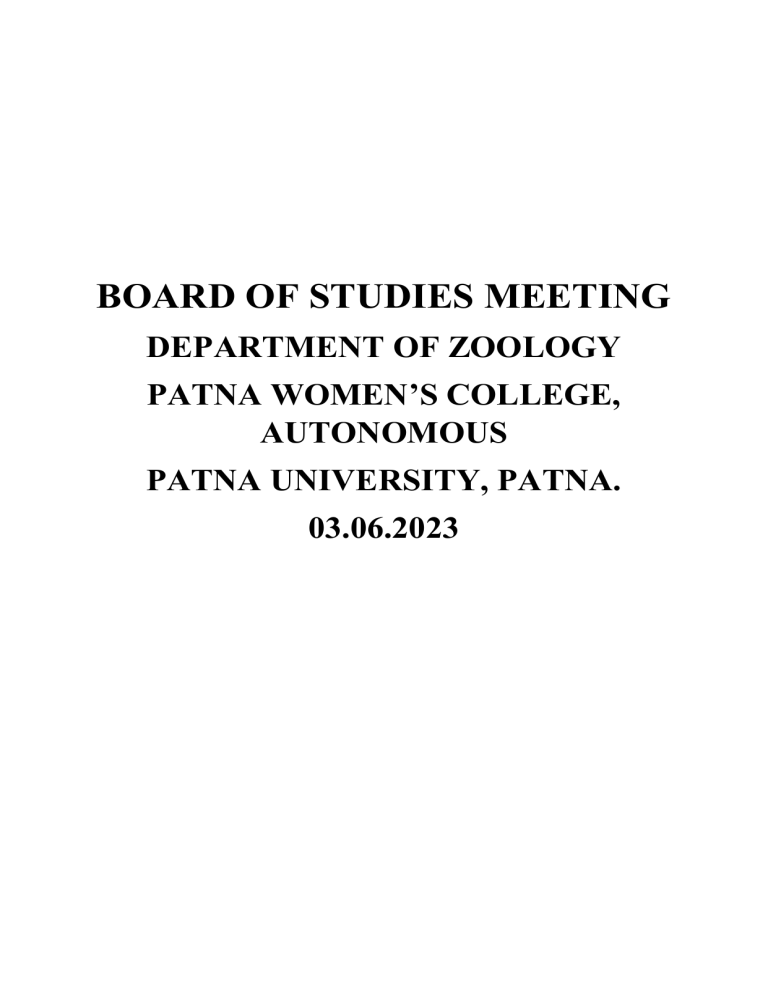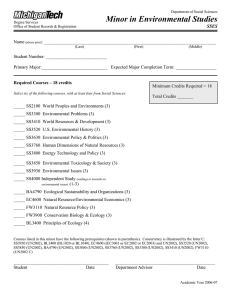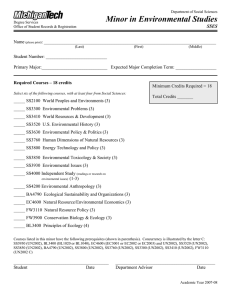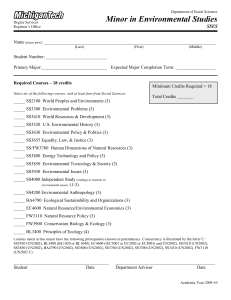
BOARD OF STUDIES MEETING DEPARTMENT OF ZOOLOGY PATNA WOMEN’S COLLEGE, AUTONOMOUS PATNA UNIVERSITY, PATNA. 03.06.2023 SEMESTER – I Major Course (MJC) (6 credits) 100 Marks Major Course 1: ZOO MJC 1: Non-Chordates I: Protists to Pseudocoelomates ZOO MJC 1: Non-Chordates I: Protists to Pseudocoelomates (Theory: 4 credits + Practical: 2 credits) Course Outcome: On completion of the course students will be able to: CO1 – Learn & interpret the importance of taxonomy and classify Protista, Porifera, Cnidaria, Platyhelminthes and Nemathelminthes. CO2 – Understand and explain the economic importance and describe the life cycle and pathogenicity of P. vivax, E. histolytica, Schistosoma haematobium, Taenia solium, Ascaris lumbricoides and Wuchereria bancrofti; CO3 – Appreciate the diversity and complexities exhibited by non-chordates and familiarize with the morphology, anatomy and functioning of different groups of non-chordates. CO4 – Critically analyze the organization, complexity, and adaptations in parasitic Nemathelminthes and Platyhelminthes, Affinities and Evolutionary significance of Ctenophora and to enhance collaborative learning through Practical sessions, Assignments and Projects. Units 1 2 3 Syllabus Protista: General characteristics & Classification up to orders, Locomotion and Reproduction in Protista. Life cycle and Pathogenicity of Plasmodium vivax and Entamoeba histolytica Porifera: General characteristics and Classification up to orders, Canal system, Spicules in sponges. Cnidaria: General characteristics and Classification up to orders, Metagenesis in Obelia, Polymorphism in Cnidaria, Corals and coral reefs. Ctenophora: General characteristics, Affinities and Evolutionary significance. Platyhelminthes: General characteristics and Classification up to orders, Life cycle and pathogenicity of Schistosoma haematobium and Taenia solium, Parasitic adaptations in Platyhelminthes. Hours 15 15 15 4 7. 8. Nemathelminthes: General characteristics and Classification up to orders, Life cycle and pathogenicity of Ascaris lumbricoides and Wuchereria bancrofti, Parasitic adaptations in Nemathelminthes 15 Practicals: 30 1. Study of WM of Paramecium, Binary fission & Conjugation in Paramecium. 2. Examination of pond water collected from different places for diversity in Protista. 3. Study of Sycon (T.S. and L.S.), Hyalonema, Euplectella 4. Study of Obelia, Physalia, Aurelia, Tubipora, Alcyonium, Metridium, Fungia, Meandrina, Madrepora. 5. One specimen / slide of any Ctenophore. 6. Study of adult Schistosoma haematobium, Taenia solium and their Life cycles (Slides / Photographs). 7. Study of adult Ascaris lumbricoides and its life stages (Slides / Photographs). 8. To submit a Project Report on any related topic from the syllabus. Note: Classification to be followed from “Ruppert and Barnes (2006) Invertebrate Zoology, 8th edition, Holt Saunders International Edition”. Reading List : 1. Ruppert and Barnes, R.D. (2006). Invertebrate Zoology, VIII Edition. Holt Saunders International Edition. 2. Barnes, R.S.K., Calow, P., Olive, P.J.W., Golding, D.W. and Spicer, J.I. (2002). The Invertebrates: A New Synthesis, III Edition, Blackwell Science 3. Barrington, E.J.W. (1979). Invertebrate Structure and Functions. II Edition, E.L.B.S. and Nelson 4. Verma P S, Jordan E L. (2009). Invertebrate Zoology. S. Chand publishers 5. Brusca R C (2016). Invertebrates. Published by Sinauer Associates, an imprint of Oxford University Press. SEMESTER – I Minor Course 1 (MIC) (3 credits) 100 Marks Minor Course 1: ZOO MIC 1: Non - chordate Diversity (Theory: 2 credits + Practical: 1 credit = 3 credits) On completion of the course students will be able to: CO1 - Understand and describe the features of Protista, Porifera and Radiata. CO2 - Understand and describe the features of Acoelomates and Pseudocoelomates and Coelomate – Protostomes. CO3 - Understand and describe the features of Arthropoda, Social life in insects with respect to Honey bees and Termites. CO4 - Understand and describe the features of Mollusca and Echinodermata, Process of Pearl Formation, Torsion in Gastropoda and Water Vascular system in Starfish. Units 1 2 3 4 Syllabus Protista: General characters of Protozoa, Life cycle of Plasmodium. Porifera: General characters and Canal system in Porifera. Radiata: General characters and Polymorphism of Cnidarians. Acoelomates: General characters of Helminthes, Life cycle of Taenia solium Pseudocoelomates: General characters of Nemathelminthes, Parasitic adaptations in Nematodes, Life cycle and pathogenicity of Wuchereria bancrofti. Coelomate – Protostomes: General characters of Annelida, Metamerism. Arthropoda: General characters, Mouthparts of Insects, Compound eye, Social life in insects with respect to Honey bees and Termites. Mollusca: General characters of Mollusca, Pearl Formation, Torsion in Gastropoda. Coelomate – Deuterostomes: General characters of Echinodermata, Water Vascular system in Starfish. Hours 7 9 8 6 Practical: 1. Study of following specimens: Sycon, Physalia, Tubipora, Metridium, Taenia, Ascaris, Nereis, Aphrodite, Leech, Peripatus, Limulus, Eupagurus, Julus, Scolopendra, Chiton, Octopus, Asterias and Antedon. 2. Study of following Permanent Slides: Euglena, Noctiluca, Paramecium, Cross section of Sycon, T.S. of Ascaris (male and female). T.S. of Earthworm passing through pharynx, gizzard, Larval forms of Echinodermata 3. Temporary mounts of Daphnia / Cyclops / Mysis 4. Project: Any assigned topic related to the Syllabus / Collection of Insects. Reading List: 1. Barnes, R.D. (1992). Invertebrate Zoology. Saunders College Pub. USA. 2. Ruppert, Fox and Barnes (2006) Invertebrate Zoology. A functional Evolutionary Approach 7th Edition, Thomson Books/Cole 3. Campbell & Reece (2005). Biology, Pearson Education, (Singapore) Pvt. Ltd. 4. Raven, P. H. and Johnson, G. B. (2004). Biology, 6th edition, Tata McGraw Hill Publications. New Delhi. 15 SEMESTER – I Multidisciplinary Course (MDC) I ZOO MDC 1: Wild Life Conservation (Theory: 2 credits + Practical: 1 credit = 3 credits) Marks: 100 Course outcome: On completion of the course students will be able to: CO 1 – Understand Positive and Negative Values of Wild life, Conservation ethics, Importance of conservation, Causes of depletion, Conservation strategies. CO 2 – Get the knowledge of Physical parameters and Biological Parameters of Habitat. CO 3 – Explain Eco tourism / Wild life tourism in forests, Concept of climax persistence, Ecology of perturbance, Rescue and rehabilitation. CO4 – Get the knowledge of National parks & Sanctuaries, Community reserve, Important features of protected areas in India, Tiger and Gangetic Dolphin conservation, Tiger reserves in India, and Enhance exposure through visit to Wild life Sanctuary, Biodiversity Park and Wetland. Units Syllabus Hours 7 1 Values of Wild life: Positive and Negative, Conservation ethics, Importance of conservation, Causes of depletion, Conservation strategies. 2 Habitat analysis: Physical parameters: Topography, Soil, and water. Biological Parameters: Food, Cover, Forage, Browse and Cover estimation. Wild life tourism: Eco tourism / Wild life tourism in forests, Concept of climax persistence, Ecology of perturbance, Rescue and rehabilitation. 7 3 Protected Areas: National parks & Sanctuaries, Community reserve, Important features of protected areas in India, Tiger and Gangetic Dolphin conservation, Tiger reserves in India. 8 4 8 Practical: 15 1. Identification of Amphibian, Reptilian, Avian, and Mammalian fauna. 2. Demonstration of basic equipment needed in Wildlife studies, Use, care, and maintenance of Compass, Binoculars, Spotting scope, Global Positioning System, Various types of Cameras and lenses. 3. Visit to Wild life Sanctuary / Biodiversity Park / Wetland. 4. Project on Photography and Identification of Flora and Fauna. Reading List: 1. Sutherland, W.J. (2000). The Conservation Handbook: Research, Management and Policy. Blackwell Sciences 2. Hunter M.L., Gibbs, J.B. and Sterling, E.J. (2008). Problem-Solving in Conservation Biology and Wildlife Management: Exercises for Class, Field, and Laboratory. Blackwell Publishing. SEMESTER – I Skill Enhancement Course (SEC) 1 ZOO SEC I: Hematology (Theory: 1 Credits + Practical: 2 Credit = 3 credits) Marks: 100 Course Outcome: On completion of the course students will be able to: CO 1 – Explain the composition of Blood, Total RBC count, Total Leukocyte Count (TLC) and Differential Leukocyte Count (DLC) CO 2 – Explain the concept of Platelet count, Erythrocyte Sedimentary Rate (ESR), Packed Cell Volume (PCV) CO 3 – Describe the ABO Blood groups, Estimation of Haemoglobin CO 4 – Prepare the Hemin crystals, Determine the Bleeding and Clotting time. Units Syllabus Hours 1 Blood composition, Total RBC count, Total Leukocyte Count (TLC) and Differential Leukocyte Count (DLC) using Leishman’s stain. 4 Platelet count using Hemocytometer, Erythrocyte Sedimentary Rate (ESR), Packed Cell Volume (PCV) 4 3 Determination of ABO Blood group, Estimation of haemoglobin using Sahli’s Haemoglobinometer 4 4 Preparation of Hemin crystals Bleeding and Clotting time 3 2 1. Practical: 30 1. Determination of ABO Blood group 2. Estimation of haemoglobin using Sahli’s Haemoglobinometer 3. Preparation of Hemin crystals 4. Bleeding and Clotting time 5. Estimation of Hematocrit value in Blood sample 6. Estimation of RBC and WBC 7. Preparation of Blood smear and Differential Leukocyte Count (DLC) using Leishman’s stain, 8. Platelet count using hemocytometer, 9. Erythrocyte Sedimentary Rate (ESR), Packed Cell Volume (PCV). Reading List: 1. Guyton, A.C. & Hall, J.E. (2006). Textbook of Medical Physiology. XI Edition. Harcourt Asia PTE Ltd. W.B. Saunders Company. 2. Tortora, G.J. & Grabowski, S. (2006). Principles of Anatomy & Physiology. XI Edition John Wiley & sons, 3. Victor P. Eroschenko. (2008). DiFiore’s Atlas of Histology with Functional correlations. XII Edition. Lippincott W. & Wilkins. 4. Vander A, Sherman J. and Luciano D. (2014). Vander's Human Physiology: The Mechanism of Body Function. XIII Edition, McGraw Hills 5. Geetha N. (2014). Textbook of Medical Physiology. Paras Medical Publisher. SEMESTER – I MIL AEC 1 – From a Basket of options given by the College – 2 Credits – 100 Marks VAC 1 – From a Basket of options given by the College – 3 Credits – 100 Marks SEMESTER II Major Course 2: ZOO MJC 2 : Principles of Ecology (Theory: 4 credits + Practical: 2 credits = 6 credits) Marks: 100 Course Outcome: On completion of the course students will be able to: CO1 – Understand and relate the key concepts in Ecology with emphasis on historical perspective, role of physical factors and Concept of Limiting factors. CO2 – Understand and explain the population attributes; Population growth models and Population interactions and describe the Community characteristics and Ecological Succession. CO3 – Understand and describe the different Ecosystems, Food chains, Energy flow & Efficiency, Biogeochemical cycles. CO4 – Learn and relate the application of the Basic Principles of Ecology in Wildlife conservation and management. Units 1 Syllabus Introduction to Ecology: History of Ecology, Levels of organization, Study of physical factors, Laws of limiting factors, Autecology and Synecology, Applied Ecology, Ecology in Wildlife conservation and management. Hours 15 2 Population: Unitary and Modular populations, Unique and group attributes of population, Density, Natality, Mortality, Age ratio, Sex ratio, Dispersal and dispersion, Life tables, Fecundity tables, Survivorship curves, Exponential and Logistic growth: Equation and patterns, r and K strategies, Population regulation: Density-dependent and Independent factors, Population interactions, Gause’s Principle with laboratory density-dependent and independent factors, Gause’s Principle with laboratory and field examples, Lotka-Volterra equation for Competition and Predation, Functional and Numerical responses. 15 3 Community: Community characteristics, Species richness, Dominance, diversity, Abundance, Vertical stratification, Ecotone, and Edge effect, 15 Ecological succession, General concepts & Theories pertaining to Climax community, Hydrarch succession, Bioindicators. 4 Ecosystem: Types of Ecosystems, Pond ecosystem in detail, Linear and Y-shaped food chains, Food chains, Food webs, Ecological pyramids, Energy flow through an ecosystem and Ecological efficiencies, General concepts of Nutrient and Biogeochemical cycle and Human Modified Ecosystem. PRACTICALS: 1. Study of Life tables and Plotting of Survivorship curves of different types from the hypothetical / real data provided. 2. Determination of Population density in a natural / hypothetical community by Quadrate method and calculation of ShannonWeiner Diversity index for the same community. 3. Study of an Aquatic ecosystem: Phytoplankton and Zooplankton, Measurement of area, determination of pH, and Dissolved Oxygen content (Winkler’s method) 4. Report on a visit to National Park / Biodiversity Park / Wild life Sanctuary / Wetlands. Reading List: 1. Colin Vaux, P. A. (1993). Ecology. II Edition. Wiley, John and Sons, Inc. 2. Krebs, C. J. (2001). Ecology. VI Edition. Benjamin Cummings. 3. Odum, E.P., (2008). Fundamentals of Ecology. Indian Edition. Brooks/Cole 4. Robert Leo Smith Ecology and field biology Harper and Row publisher 5. Ricklefs, R.E., (2000). Ecology. V Edition. Chiron Pres 15 30 SEMESTER – II Minor Course 2: ZOO MIC 2: Chordate Diversity 100 Marks (Theory: 2 credits + Practical: 1 credits) On completion of the course students will be able to: CO1 - Understand and describe the Salient features of Pisces, Migration of Fishes and Parental Care. CO2 - Understand and describe the General characters of Amphibia, Adaptations for terrestrial life, Parental care in Amphibia. CO3 - Understand and describe the General Characters of Reptiles and Aves, Origin of reptiles, Terrestrial adaptation in Reptiles, Origin of birds, Flight adaptations in birds. CO4 - Understand and describe the General Characters of Mammalia, Early evolution of Mammals and Dentition in mammals. Units Syllabus Hours 1 Protochordata: Salient features Pisces: General Characters, Migration of Fishes, Parental Care 7 2 Amphibia: General characters, Adaptations for terrestrial life, Parental care in Amphibia. 7 3 Reptiles: General Characters, Origin of reptiles, Terrestrial adaptation in Reptiles. Aves: General Characters, Origin of birds; Flight adaptations. 9 4 Mammalia: General Characters, early evolution of mammals; Dentition in mammals. Practical: 1. Study of following specimens: Chordates: Balanoglossus, Amphioxus, Petromyzon, Hippocampus, Exocoetus, Ichthyophis, Salamander, Alytus Draco, Uromastix, Naja, Viper, Chart of Archaeopteryx, Parrot, Hen, Sparrow, Squirrel, and Bat. 2. Study of following permanent Slides: Placoid scales, Cycloid scales and Ctenoid scales 3. Identification of Poisonous and Non-poisonous snakes 4. Parental care in animals. 7 15 Reading List: 1. Barnes, R.D. (1992). Invertebrate Zoology. Saunders College Pub. USA. 2. Ruppert, Fox, and Barnes (2006) Invertebrate Zoology. A functional Evolutionary Approach 7th Edition, Thomson Books/Cole 3. Campbell & Reece (2005). Biology, Pearson Education, (Singapore) Pvt. Ltd. 4. Kardong, K. V. (2002). Vertebrates Comparative Anatomy. Function and Evolution. Tata McGraw Hill Publishing Company. New Delhi. 5. Raven, P. H. and Johnson, G. B. (2004). Biology, 6th edition, Tata McGraw Hill Publications. New Delhi. SEMESTER – II Multidisciplinary Course (MDC) 2 ZOO MDC 2: Wild Life Management (Theory: 2 credits + 1 Practical: 3 credits) Marks: 100 Course outcome: On completion of the course students will be able to: CO 1 – Understand different types of habitats, Grazing logging, Cover construction, Preservation of genetic diversity and Restoration of degraded habitats under management of habitats. CO 2 – Gain knowledge of Population estimation, Population density, Natality, Birth rate, Mortality, Fertility schedules and Sex ratio computation. CO 3 – Understand Standard evaluation procedures, Remote sensing and GIS, Bio-telemetry, Estimation of carrying capacity. CO 4 – Understand the concept of Care of injured and diseased animal, Quarantine, Common diseases of wild animal, Man-Animal conflict, Faecal analysis of ungulates and carnivores, Faecal samples, Slide preparation, Hair identification, Pug marks and Census method. Units Syllabus Hours 1 Management of habitats: Setting back succession; Grazing logging; Mechanical treatment; Advancing the successional process; Cover construction; Preservation of genetic diversity, Restoration of degraded habitats. 8 Population estimation: Population density, Natality, Birth rate, Mortality, fertility schedules and sex ratio computation. 7 2 3 7 Standard evaluation procedures: Remote sensing and GIS, Biotelemetry, Estimation of carrying capacity. 4 Management of Wild Animals: Care of injured and diseased animal; Quarantine; Common diseases of wild animal, Man-Animal conflict; Faecal analysis of ungulates and carnivores: Faecal samples, slide preparation, Hair identification, Pug marks and census method. 8 Practical: 1. Familiarization and study of animal evidences in the field; Identification of animals through pug marks, hoof marks, 15 scats, pellet groups, nest, antlers etc. 2. PCQ, Ten tree method, Circular, Square & rectangular plots, ground cover assessment, Tree canopy cover assessment, Shrub cover assessment. 3. Trail / transect monitoring for abundance and diversity 4. Estimation of mammals and bird (direct and indirect evidences) 5. Project on related topics. Reading List : 1. Caughley, G., and Sinclair, A.R.E. (1994). Wildlife Ecology and Management. Blackwell Science. 2. Woodroffe R., Thirgood, S. and Rabinowitz, A. (2005). People and Wildlife, Conflict or Co-existence? Cambridge University. 3. Bookhout, T.A. (1996). Research and Management Techniques for Wildlife and Habitats, 5 th edition. The Wildlife Society, Allen Press. 4. Sutherland, W.J. (2000). The Conservation Handbook: Research, Management and Policy. Blackwell Sciences 5. Hunter M.L., Gibbs, J.B. and Sterling, E.J. (2008). Problem-Solving in Conservation Biology and Wildlife Management: Exercises for Class, Field, and Laboratory. Blackwell Publishing. SEMESTER – II Skill Enhancement Course (SEC) 2 ZOO SEC 2: Medical Diagnostics (Theory: 1 credit + Practical: 2 credits = 3 credits) Marks: 100 Course Outcome: On completion of the course students will be able to: CO1 – Explain Medical diagnostics and its importance, Methods of detection such as medical imaging: X-ray of bone fracture, PET, MRI, and CT scan (using photographs). CO2 – Understand the diagnostics methods used for Analysis of urine, Blood Pressure, Pulse rate, and Blood Glucose level. CO3 – Describe and distinguish infectious diseases and non-infectious diseases, their causes, types, symptoms, complications, diagnosis, and preventions. CO4 – Explain types of Tumours and detection of Tumours, Metastasis, Angiogenesis Units Syllabus Hours 1 Introduction to Medical Diagnostics and its Importance Medical imaging: X-ray of Bone fracture, PET, MRI, and CT scan (using photographs). 2 2 Diagnostic Methods: Urine Analysis: Physical characteristics, Abnormal constituents, Blood Pressure, Pulse rate, Blood Glucose level, SGPT 4 3 4 Non-infectious Diseases: Causes, types, symptoms, complications, diagnosis, and prevention of Diabetes (Type I and Type II), Hypertension (Primary and Secondary), Testing of blood glucose using Glucometer / Kit. Infectious Diseases: Causes, types, symptoms, diagnosis and prevention of Tuberculosis and Hepatitis. Tumours: Types (Benign / Malignant), Detection of Tumours, Metastasis, Angiogenesis. 6 3 Practical: 1. Urine Analysis: Physical characteristics; Abnormal constituents 2. Blood Pressure, Pulse rate, Blood Glucose level 3. Project on Medical imaging: X-ray of Bone fracture, PET, MRI, and CT scan. 4. Preparation of Report on Non-infectious Diseases and Infectious Diseases 30 Reading List: 1. Leeuwen AMV, Bladh ML (2017). Davis's Comprehensive Handbook of Laboratory and Diagnostic Tests with Nursing Implications. F.A. Davis Company; 7th edition 2. Buckingham L (2011). Molecular Diagnostics: Fundamentals, Methods, and Clinical Applications. F.A. Davis Company; 2nd edition 3. Merck Editor (2011). The Merck Manual of Diagnosis and Therapy. Elsevier Health Sciences 4. Captain C, Banerjee P. (2014). Common Laboratory Tests Used by TCM Practitioners: When to Refer Patients for Lab Tests and How to Read and Interpret the Results. Jessica Kingsley Publishers. 5. Andersson D, Creations M (2018). Lab Values: Everything thing You Need to Know about Laboratory Medicine and its Importance in the Diagnosis of Diseases. SEMESTER – II MIL AEC 2 - From a Basket of options given by the College – 2 Credits – 100 Marks VAC 2 - From a Basket of options given by the College – 3 Credits – 100 Marks





